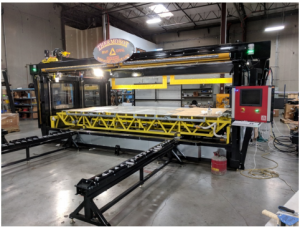In a paper entitled “Vinylester and Polyester 3D Printing,” researchers at Oak Ridge National Laboratory (ORNL) teamed up with researchers from Polynt Composites USA to evaluate the feasibility of 3D printing vinylester and polyester materials. The two organizations worked together to assess Polynt base material chemistries for large scale polymer additive manufacturing.
The project consisted of three tasks: rheology and reaction kinetics; solvents, build sheets and safety analysis; and proof of concept demonstration.
“The printability of polyester or vinylester resins is driven primarily by the rheology and reaction kinetics of the polymers,” the researchers state. “These properties can be controlled through chemistry modification and by incorporating additives. The ability to control these properties distinguishes reactive additive manufacturing(AM) from thermoplastic AM, which is driven largely by temperature gradients that can’t be controlled. Polymers tested in Phase 1 of this project had viscosity of 300-700 centipose (cP), with reaction times ranging from 9 to 40 minutes.”
The researchers then evaluated safety considerations for the large scale 3D printing of vinylester and polyester materials. Some of the main concerns addressed involved explosion and health and safety properties of styrene. Low cost Mylar sheets were used for the first phase of the project, and acetone was used for the cleaning of the equipment.
 As a proof of concept, the researchers used a Thermobot from Magnum Venus Products to 3D print demonstration articles to show the feasibility of printing vinylester and polyester materials. Quasi-status tensile tests were performed on the 3D printed items for both the X and Z axes. Results showed that this new class of reactive polymers will outperform existing thermoplastic materials used for large scale additive manufacturing. Also, the reduction of properties from print direction (X) to build direction (Z) is only 29 percent, a less significant decrease than for most thermoplastic materials.
As a proof of concept, the researchers used a Thermobot from Magnum Venus Products to 3D print demonstration articles to show the feasibility of printing vinylester and polyester materials. Quasi-status tensile tests were performed on the 3D printed items for both the X and Z axes. Results showed that this new class of reactive polymers will outperform existing thermoplastic materials used for large scale additive manufacturing. Also, the reduction of properties from print direction (X) to build direction (Z) is only 29 percent, a less significant decrease than for most thermoplastic materials.
“Standard toolpath planning strategies were adopted from thermoplastic printers,” the researchers continue. “However, it was demonstrated that materials evaluated in this project allowed greater freedom in toolpath planning since it was possible to cross a previously deposited bead without stopping and pausing the print. Eliminating stops at bead cross-overs will result in significant time savings and possibly an improvement in the mechanical properties of printed structure.”
Overall, the project showed that polyester and vinylester materials are promising for large scale additive manufacturing.
“High strength values compared to existing thermoplastic additive material have been demonstrated along with less than 30% reduction in Z strength compared to print direction strength,” the researchers conclude. “These materials require no energy input during printing and have been shown to offer increased freedom in toolpath planning. Additionally, carbon fiber, or other additives with low coefficients of thermal expansion, are not required to achieve large scale prints, presenting the possibility of introducing low cost materials for large scale AM.”
The researchers successfully met their goals in Phase 1 of the project, demonstrating the feasibility of using polyester and vinylester for large scale additive manufacturing. The next step is to achieve taller builds and optimize material properties for consistent deposition with available equipment. The researchers believe that these materials could be used in applications requiring strength beyond the reach of existing thermoplastic 3D printing materials.
Authors of the paper include John Ilkka, Steve Voeks, John Lindahl and Vlastimil Kunc.
Discuss this and other 3D printing topics at 3DPrintBoard.com or share your thoughts below.
Subscribe to Our Email Newsletter
Stay up-to-date on all the latest news from the 3D printing industry and receive information and offers from third party vendors.
You May Also Like
Printing Money Episode 17: Recent 3D Printing Deals, with Alex Kingsbury
Printing Money is back with Episode 17! Our host, NewCap Partners‘ Danny Piper, is joined by Alex Kingsbury for this episode, so you can prepare yourself for smart coverage laced...
Insights from Cantor Fitzgerald on AM’s Q1 2024 Landscape
A recent survey by Cantor Fitzgerald sheds light on the persistent challenges within the additive manufacturing (AM) industry in the first quarter of 2024. Based on responses from 38 industry...
3D Printing Financials: Xometry’s Scaling up and Strong Start to 2024
Xometry (Nasdaq: XMTR) kicked off 2024 with strong results, boosting its marketplace and technology to new heights. Both revenue and gross margin soared, fueled by an expanding global network of...
3D Printing Financials: Desktop Metal Targets Recovery Amid Net Losses and Revenue Downturn
Despite facing a decline in revenue and the persistent challenges of a tight economic climate, Desktop Metal (NYSE: DM) is making strides toward operational efficiency. The first quarter of 2024...


































